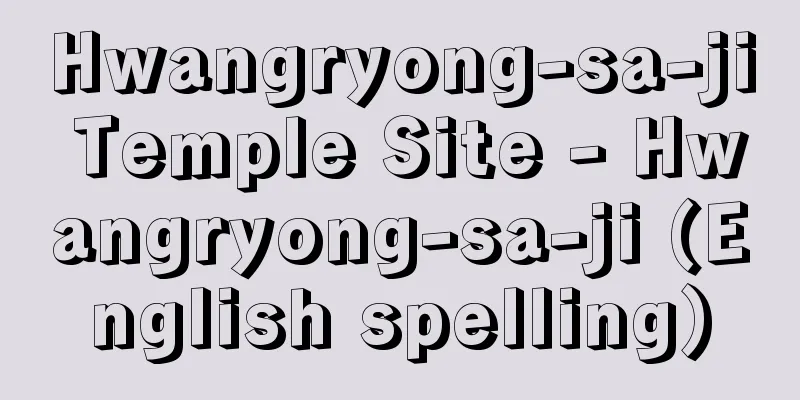Lake Teganuma

|
This lake is located on the right bank of the downstream Tone River in northwestern Chiba Prefecture. It is long and narrow from east to west, with a circumference of 38 kilometers, an area of 6.5 square kilometers, and a maximum depth of 3.8 meters. In the early modern period, the Tone River was diverted to flow into the Pacific Ocean at Choshi, causing sediment to flow back and accumulate, filling in the entrance to the Katori Sea and forming a swamp. Since the Edo period, land reclamation has been carried out along the lake shore, and new rice paddy settlements have increased, but the damage from repeated floods has been great. In 1946 (Showa 21), the Ministry of Agriculture and Forestry began land reclamation with the aim of increasing food production, and when it was completed in 1968, the eastern half of the lake was completely converted into rice paddies, and the scale of farming by surrounding farmers expanded. Since the Meiji period, writers such as Shiga Naoya and Mushanokoji Saneatsu have lived on the shores of the lake, and it has been called the Kamakura of the North, but in recent years, there has been significant residential development along the JR Joban and Narita lines. As a result, household wastewater has flowed into the lake, causing it to become increasingly polluted, to the point where it now has the highest water pollution in the country. Purification measures are being taken, and the lake is now subject to the Special Measures Act for the Conservation of Lake and Pond Water Quality. The area has been designated as the Prefectural Inbatega Nature Park, and is filled with lush wild rice and reeds, as well as many carp and crucian carp, so people visit the area for fishing, boating, and walking. [Yamamura Junji] Reclamation in the Edo PeriodDuring the Edo period, there were frequent plans to reclaim Lake Teganuma, and large-scale construction work was carried out four times. The first was planned by the shogunate's magistrates Hosoda Tokinori and Chikayama Yasutaka in connection with the excavation of the Tone River and the reclamation of Lake Inbanuma, and was undertaken by Edo townspeople Yorozuya Jiemon and 17 others as contractors. According to the contract document from 1671 (Kanbun 11), the contractor was required to serve for seven years, with all funds provided by the contractor, and because of the large-scale construction work, the contractor was granted development rights for Isabu-no (where Teganuma Shinden was established) and Oose-no. Shortly after, many townspeople withdrew due to lack of funds, but Unnoya Sakubei, who participated as a witness, and others fought hard and established small-scale new fields around the swamp, such as Hosaku Shinden. The second project was carried out in 1727 (Kyoho 12) by Shinden-kata Izawa Tamenaga of the Shogunate Accounting Office and Sichuan Magistrate Takada Jizaemon at public expense, building a Senken-tei embankment to divide the swamp into upper and lower parts, and successfully reclaiming Shimonuma, which came under the control of the Shinden-kata, but later failed when the Senken-tei broke due to a flood. The third event was held in 1738 (Genbun 3), when Sajihee, a local Aijima Shinden headman, and two others became heads of the operation, with the cooperation of Negishi Gen'emon and Edo Suruga-ya Gonbei of the Oshi domain in Musashi Province. After the event was successful, the share of the profits was 60% for the donor, 20% for the head, and 20% for Negishi and Suruga-ya, but it ended in failure. The fourth event was held at the discretion of the Shogunate magistrate Miyamura Takatoyo, and was carried out by the Shogunate Accounting Office at public expense. In conjunction with the reclamation of Lake Inban, the closure of the Eda Tone River (now the Shogen River) was carried out to allow the water from Lake Teganuma to flow into the Nagato Bori, but the closure levee collapsed due to flooding, and the operation failed. [Sadao Otani] Source: Shogakukan Encyclopedia Nipponica About Encyclopedia Nipponica Information | Legend |
|
千葉県北西部、利根川(とねがわ)下流右岸にある湖沼。東西方向に細長く、周囲38キロメートル、面積6.5平方キロメートル、最深3.8メートル。近世初期に利根川が銚子(ちょうし)で太平洋に注ぐ流路に変えられたため逆流した土砂が堆積(たいせき)し、香取海(かとりうみ)の入口が埋められて沼となった。江戸時代より湖岸に沿って干拓が行われて新田(しんでん)集落が増えたが、たび重なる洪水の被害は大きかった。1946年(昭和21)食糧増産を目的として農林省が干拓を進め、1968年に完成して湖の東半部は完全に水田化され、周辺農家の経営規模は拡大した。明治以後、志賀直哉(しがなおや)、武者小路実篤(むしゃのこうじさねあつ)などの文人が沼畔に住み、北の鎌倉とよばれたが、近年はJR常磐(じょうばん)線、成田線沿線の住宅地開発が著しい。そこで家庭雑排水が流入して湖の汚濁が進み、水質汚濁全国一の値を示すほどになってその浄化対策が図られており、湖沼水質保全特別措置法の対象となっている。一帯は県立印旛手賀自然公園(いんばてがしぜんこうえん)に指定され、マコモ、ヨシが茂り、コイ、フナも多く、釣りやボート遊び、散策に人が訪れる。 [山村順次] 江戸時代の干拓手賀沼は、江戸時代にしばしば干拓が計画され、4回にわたって大規模な普請が実施された。第1回は、幕府の代官細田時徳・近山安高が新利根(とね)川の開鑿(かいさく)・印旛沼(いんばぬま)干拓などと関連づけ見立てたもので、江戸町人万屋治右衛門(よろずやじえもん)ら17名が請方(うけかた)となり開始した。1671年(寛文11)の請負(うけおい)証文によると、鍬下年季(くわしたねんき)7年、資金は自分持(もち)、大規模な普請を理由に伊佐部(いさぶ)野(手賀組新田が成立)、大瀬(おおせ)野の開発権の取得などが記されている。直後、資金難で離脱する町人が続出し、証人として参画していた海野屋作兵衛(さくべえ)らが奮闘し発作(ほっさく)新田など沼周辺の小規模新田が成立した。第2回は、幕府勘定所(かんじょうしょ)の新田方井沢為永(ためなが)、四川奉行(ぶぎょう)高田次左衛門(じざえもん)らが1727年(享保12)に公費で実施し、千間堤を築いて沼を上下に区分し、下沼の干拓に成功し新田方の支配下に置かれたが、のち洪水で千間堤が決壊し失敗。第3回は、1738年(元文3)に地元相島(あいじま)新田名主佐治兵衛(さじへえ)ら3名が頭取となり、武蔵(むさし)国忍(おし)領の根岸源右衛門(げんえもん)・江戸駿河屋権兵衛(するがやごんべえ)らの協力を得て実施。成功後の分け前は金主6割・頭取割・根岸と駿河屋2割であったが失敗に終わる。第4回は、幕府代官宮村高豊(たかとよ)の見立てで、幕府勘定所が公費で実施。印旛沼の干拓と連動させ、枝(えだ)利根川(現、将監(しょうげん)川)の負俵口(まけだわらぐち)を締め切り、手賀沼の水を長門(ながと)堀に流下させたが、洪水のため締切堤が決壊し失敗した。 [大谷貞夫] 出典 小学館 日本大百科全書(ニッポニカ)日本大百科全書(ニッポニカ)について 情報 | 凡例 |
>>: Decadent - Decadent is (English spelling) décadent
Recommend
Hondo - Hondo
〘noun〙① The main central road. The main road as op...
Seika [town] - Seika
A town in Soraku County, located on the west bank ...
Eshiki Sakura - Eshiki Sakura
〘Noun〙 (Named after the fact that it blooms around...
Ibn al-Labbād (English spelling)
…Born in Baghdad, he was active in Iraq, Syria, a...
Zhang Lu - Choro
Date of birth and death unknown. A Chinese Taoist...
Buy - mǎi ban (English spelling)
A merchant who is subordinate to a foreign capital...
double harp
…It replaced the medieval Romanesque harp in the ...
Spender, Stephen (Harold)
Born: February 28, 1909, London [died] July 16, 19...
Yale College
…One of the Ivy League schools. The third oldest ...
Conioselinum filicinum (Wolff) Hara
A perennial plant of the Apiaceae family that grow...
Periglacial landforms
A topography found in permafrost regions where th...
Sanju
Title of a piece of gagaku. Left side. New music. ...
Currency reform - Heisei Kaikaku
This refers to the reform of China's monetary...
Unwin, R.
… His proposal was seen by many as a utopian drea...
Amagikanaoi - Amagikanaoi
...It was introduced to Europe by P.F. von Siebol...


![Shimane [town] - Shimane](/upload/images/67cbca3f27c2f.webp)
![Engaru [town] - Engaru](/upload/images/67cb0cf18827e.webp)



![Kawachinagano [city]](/upload/images/67cb469c1d1ef.webp)

